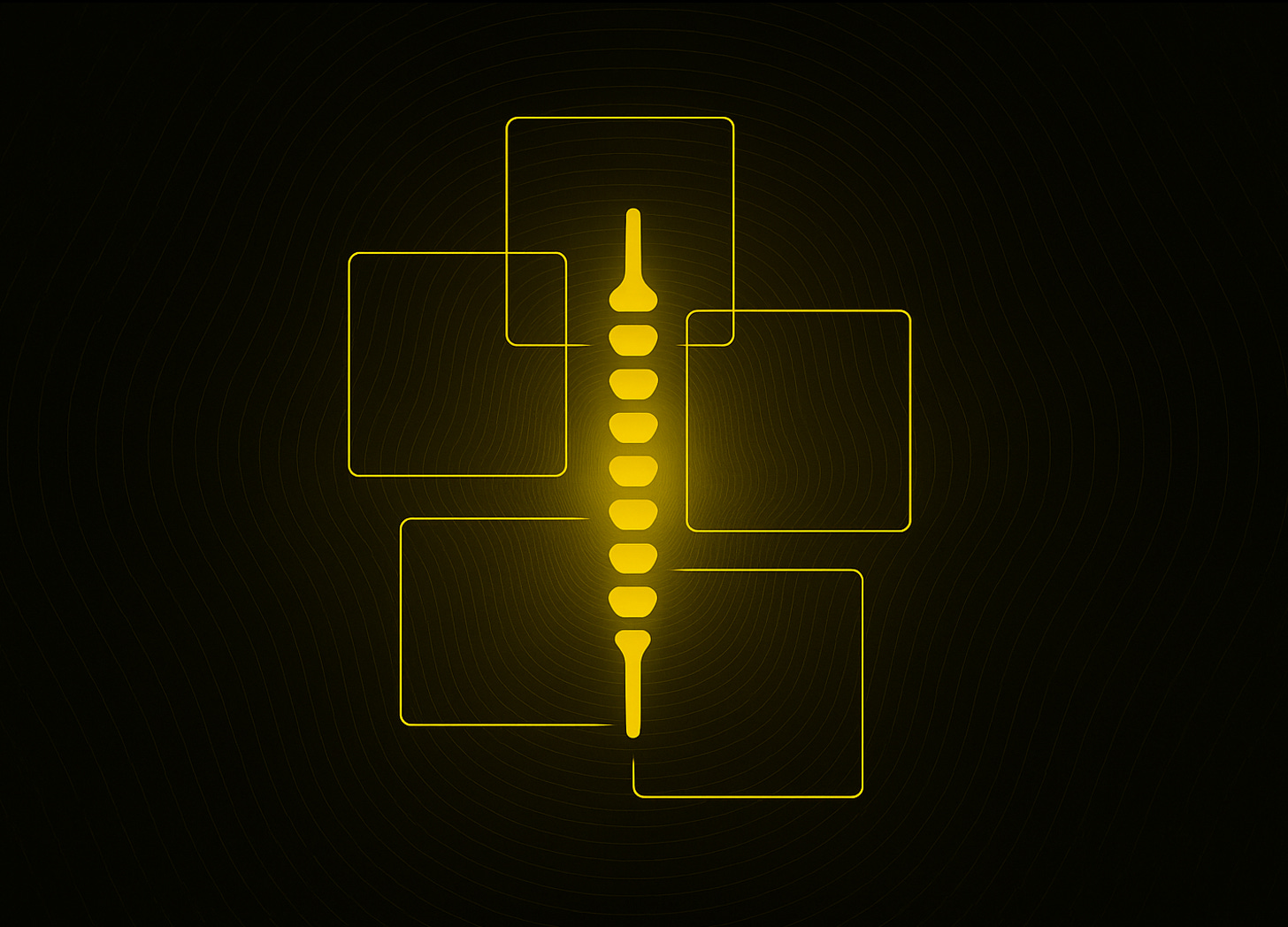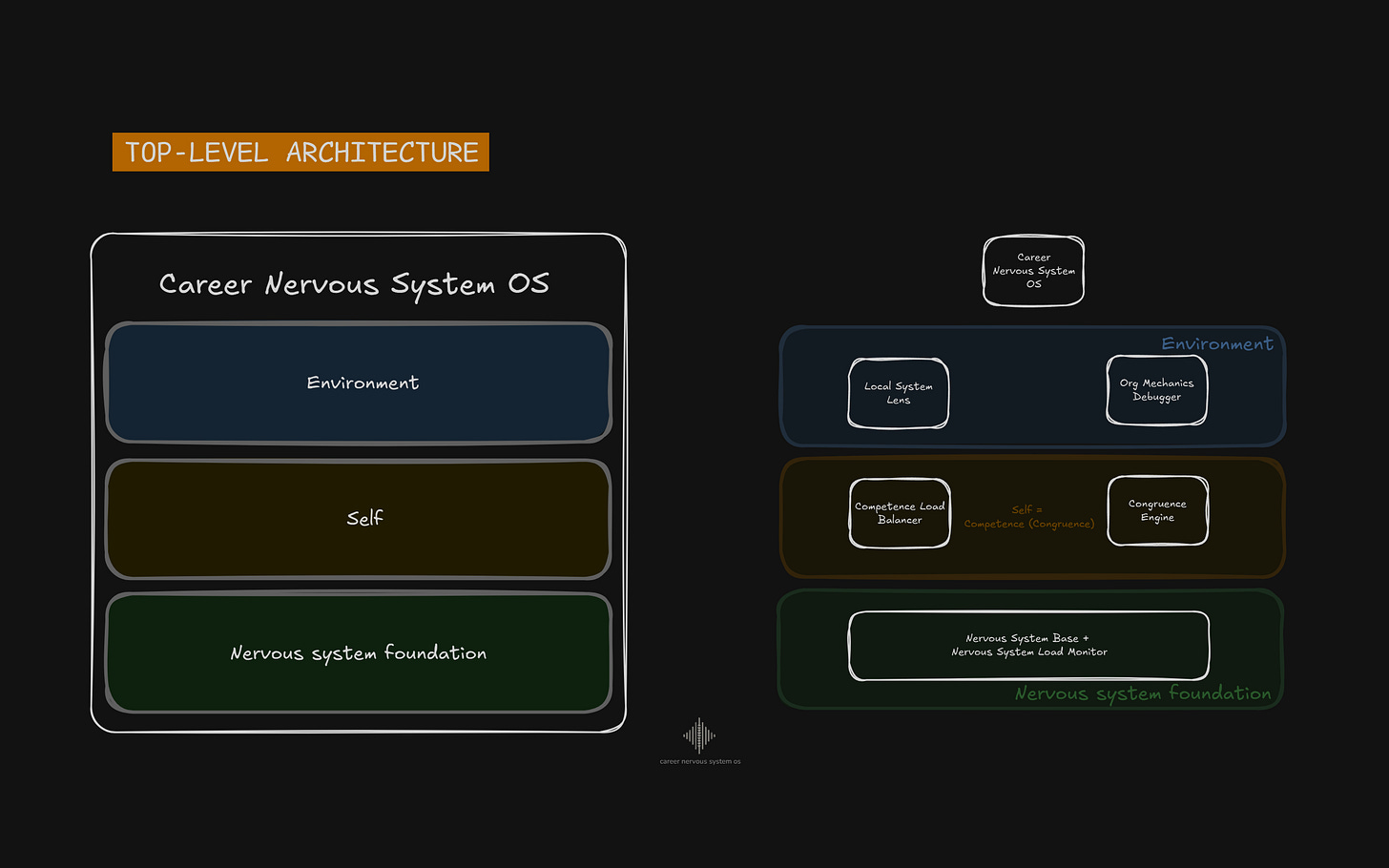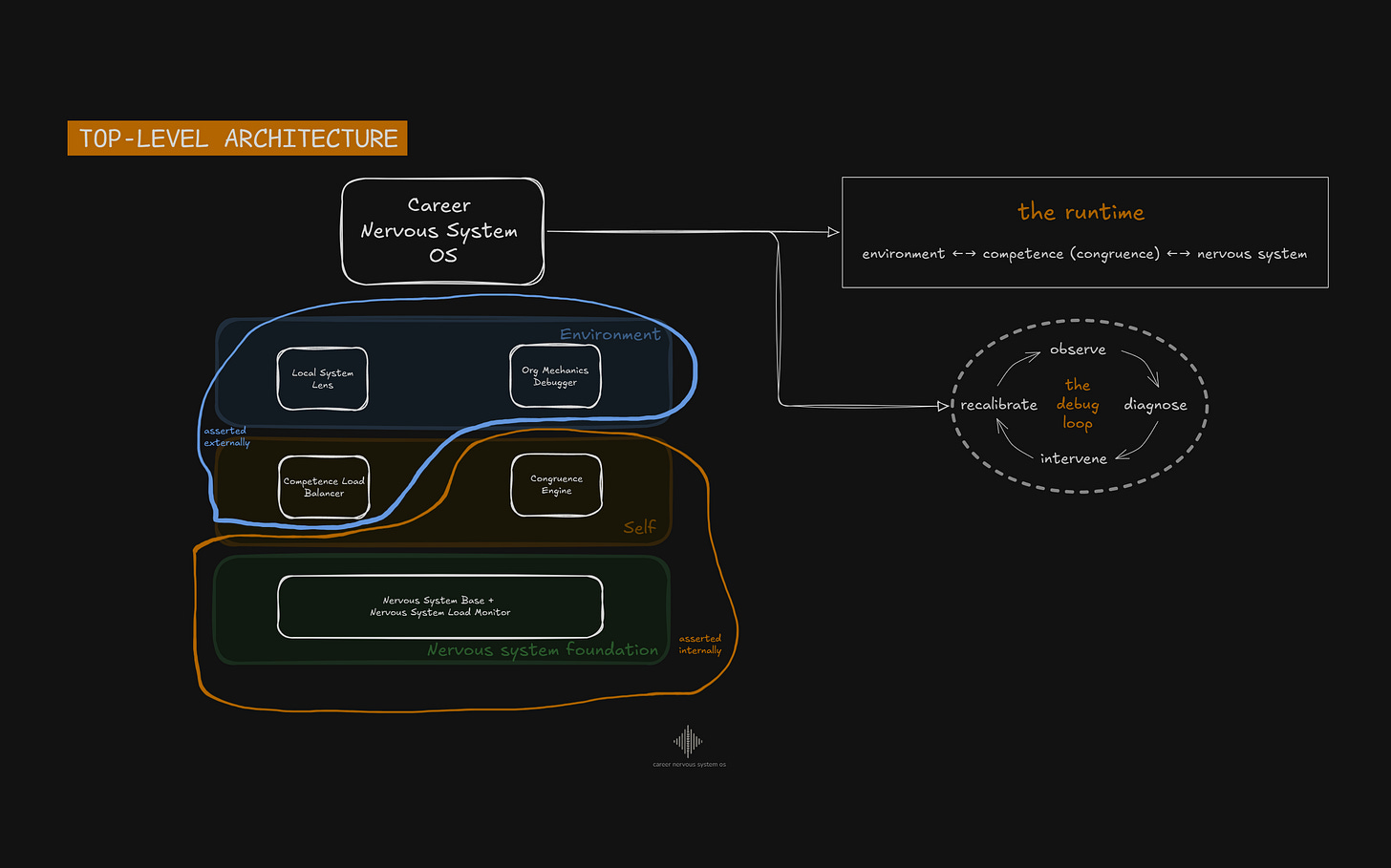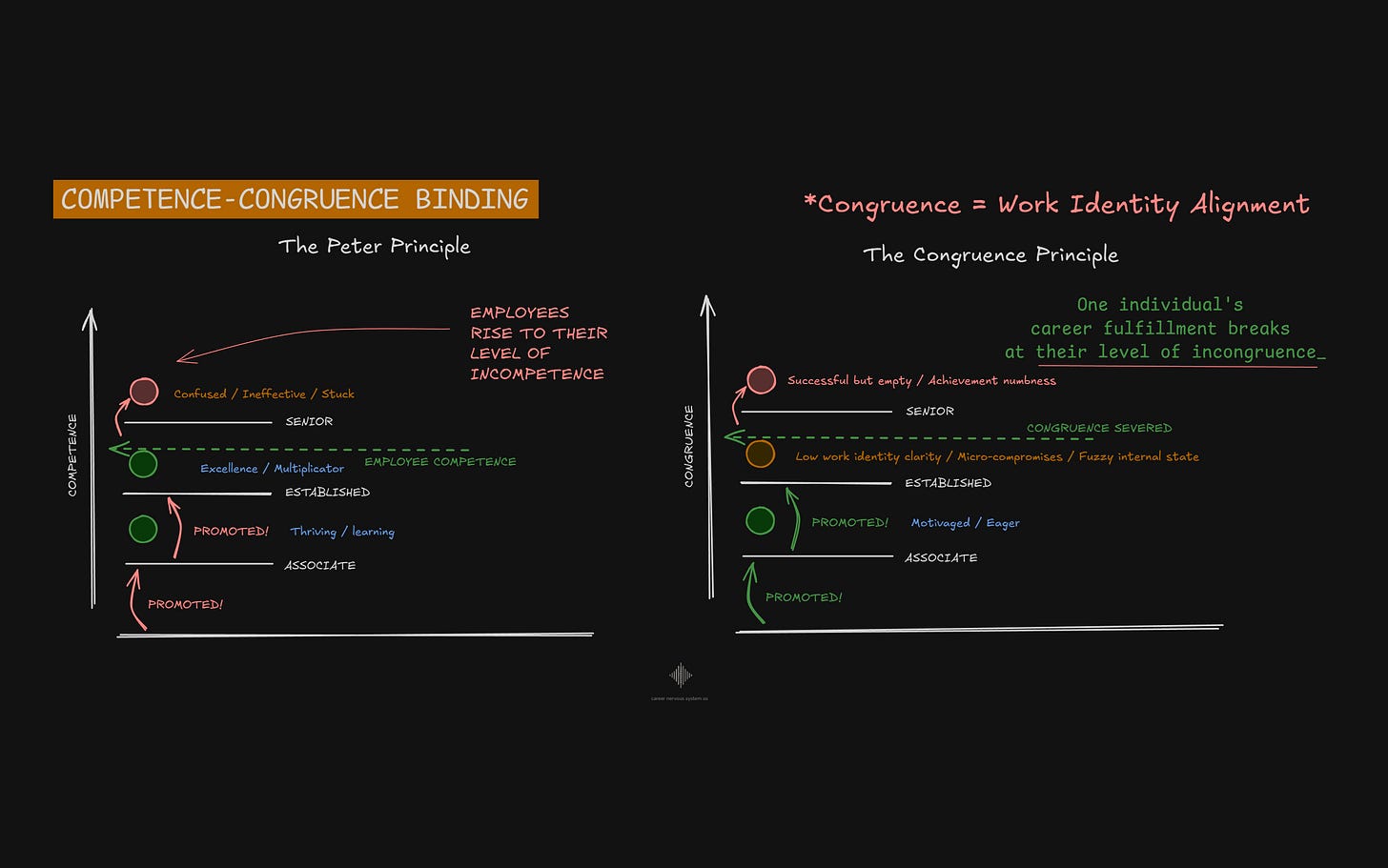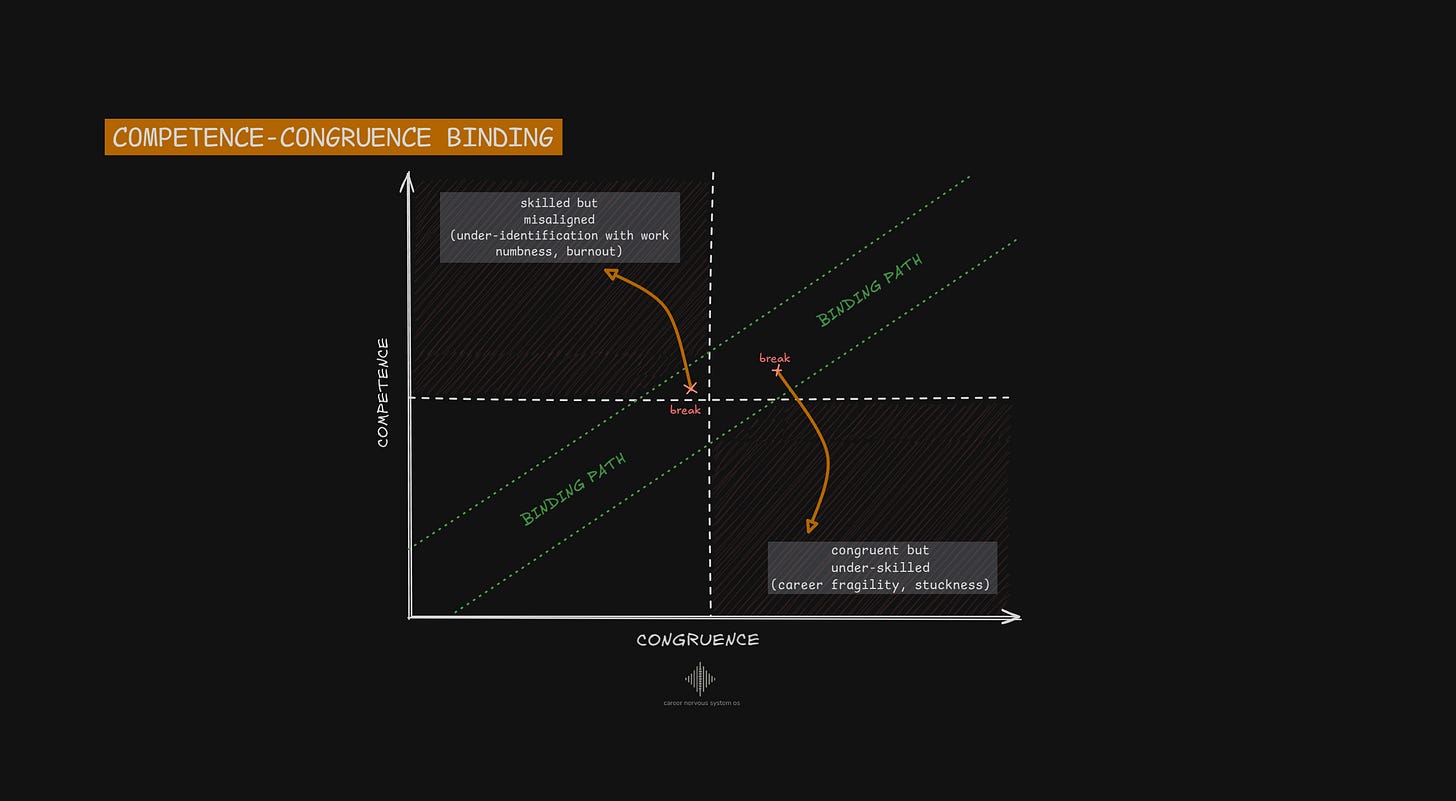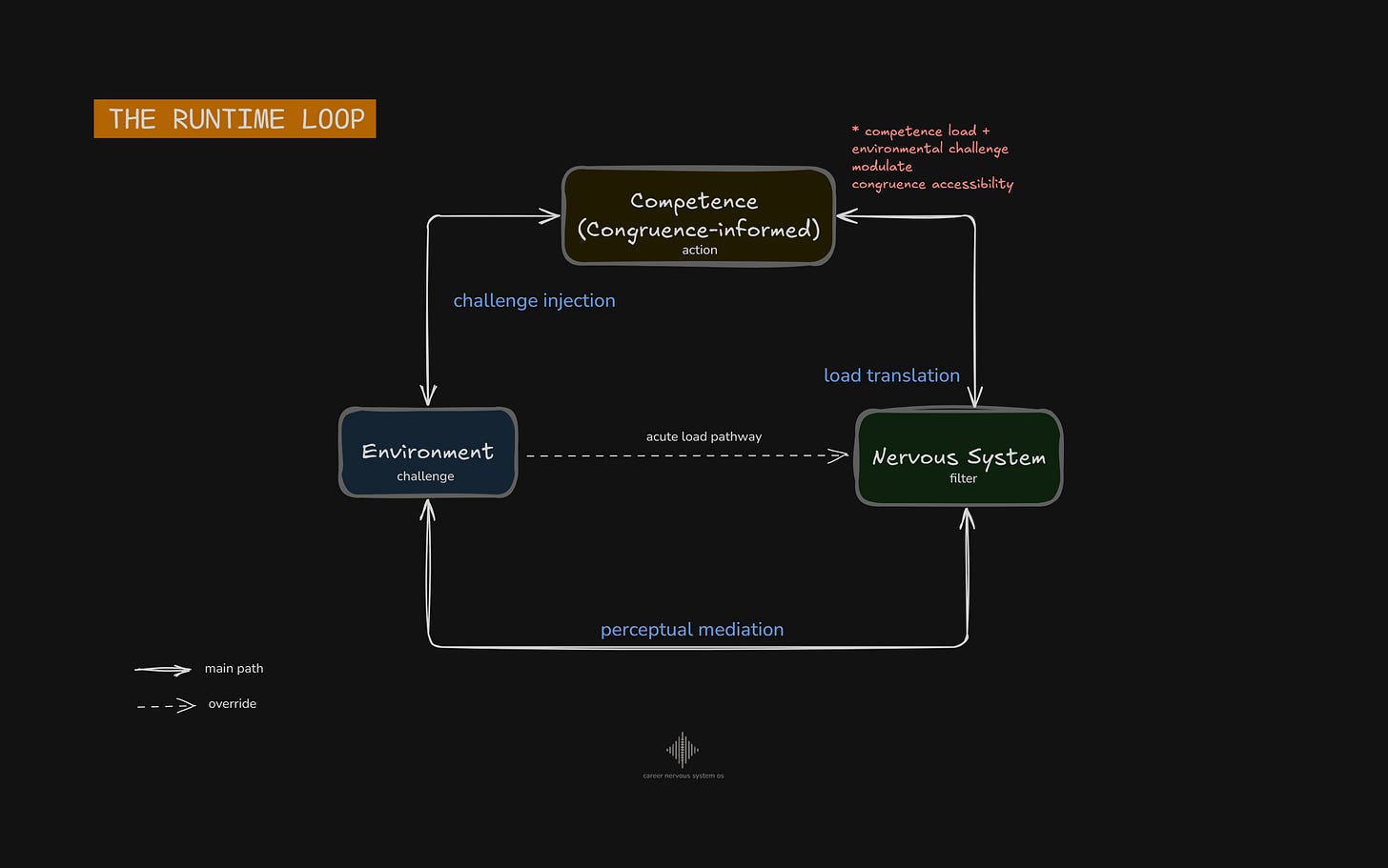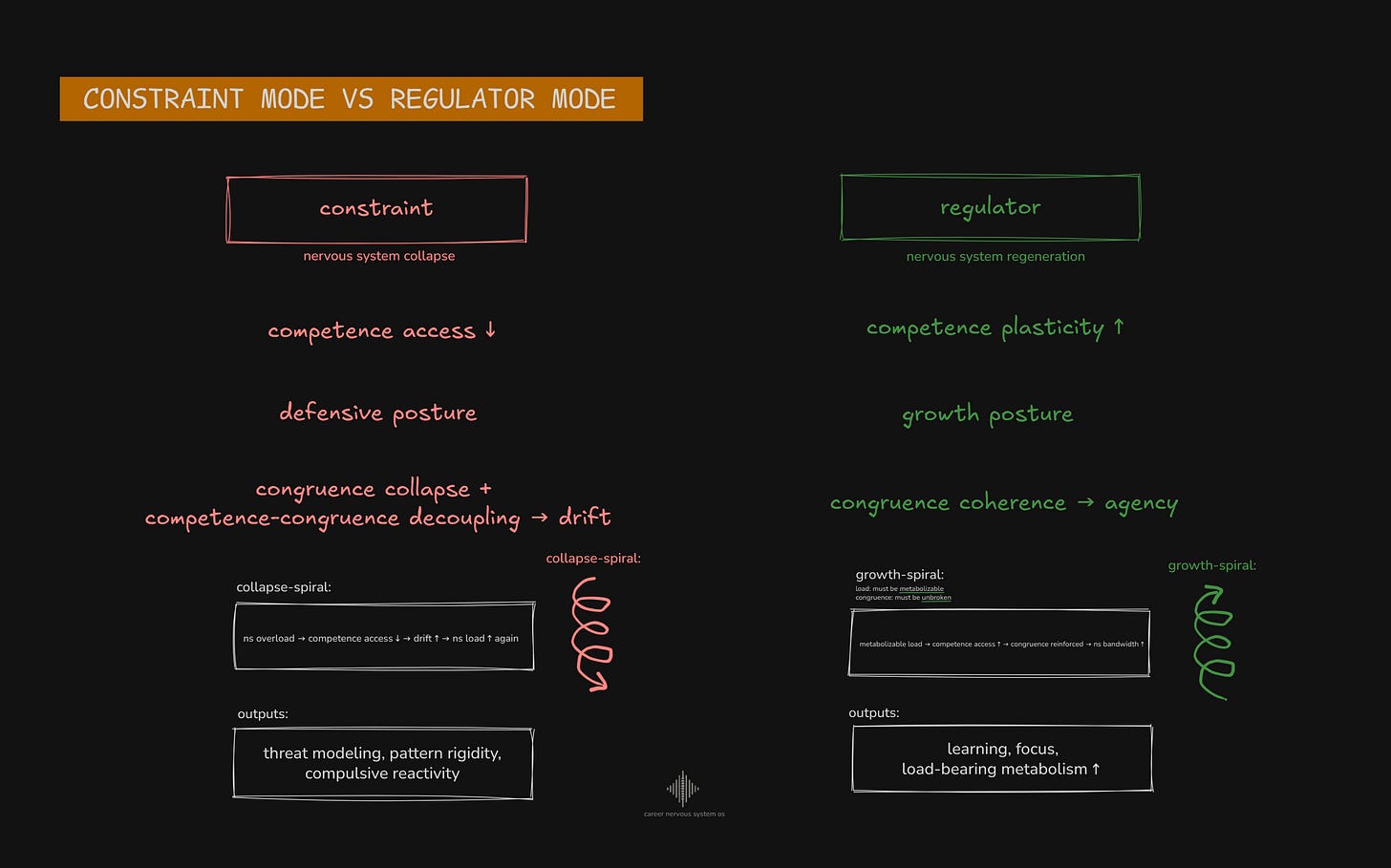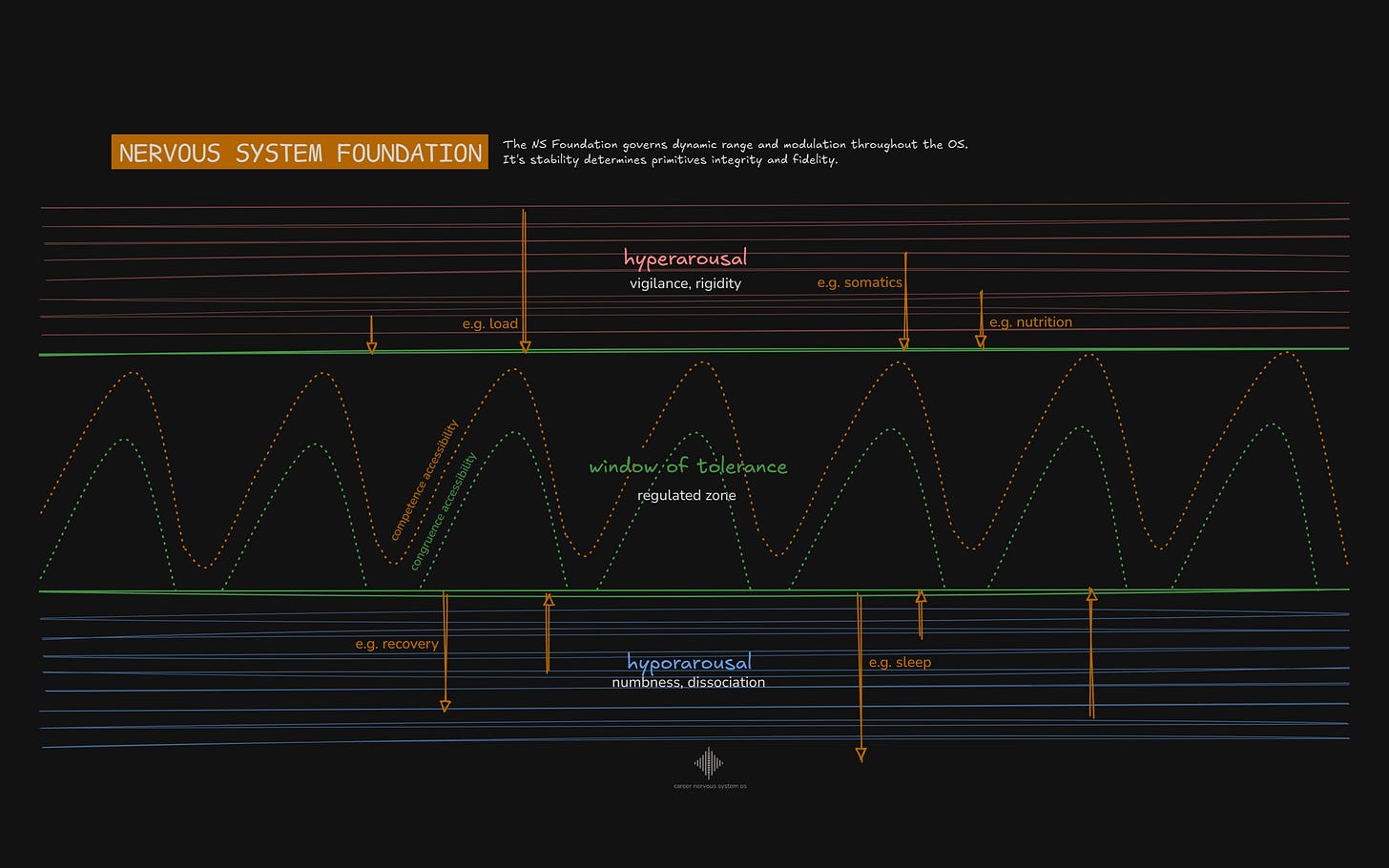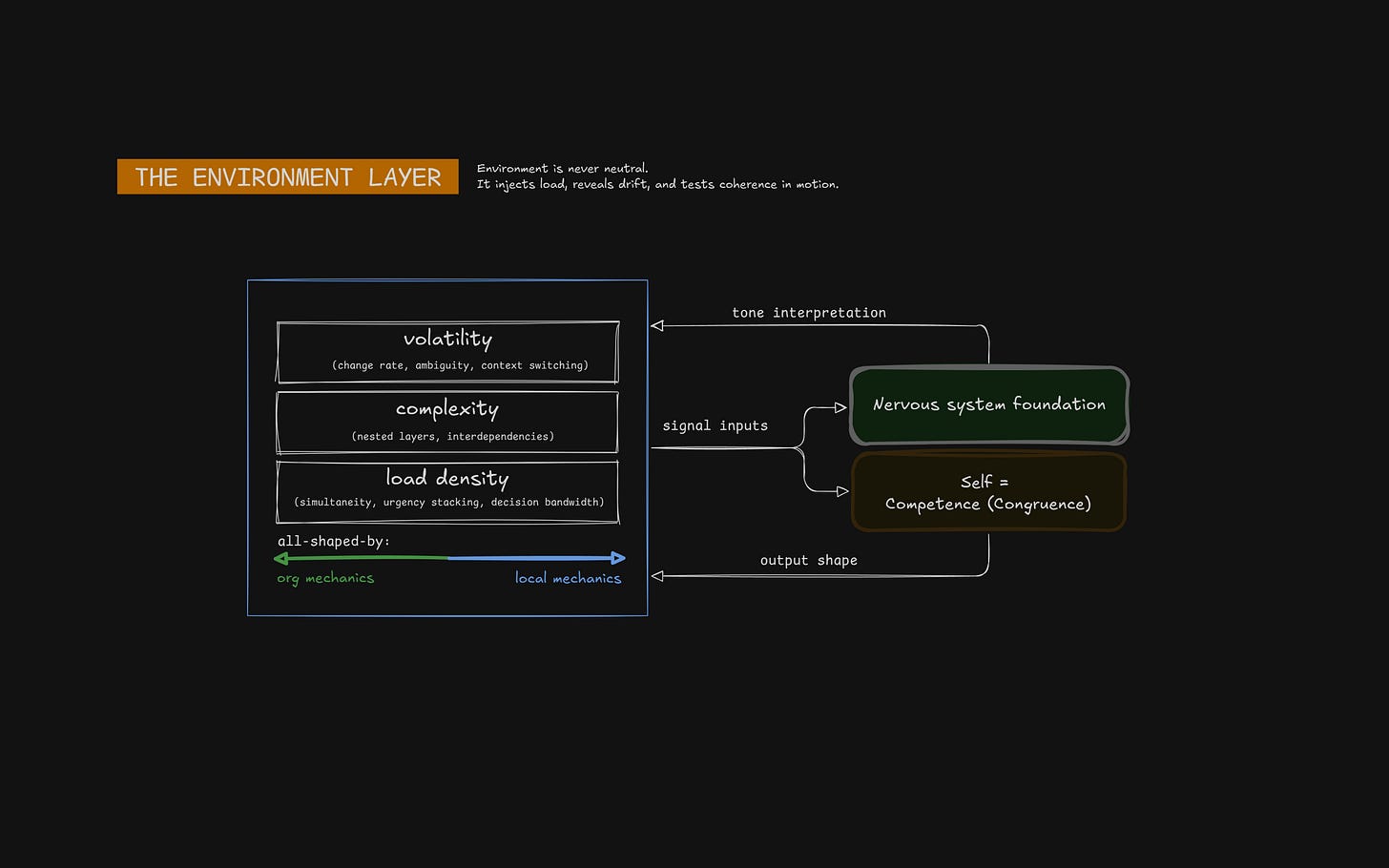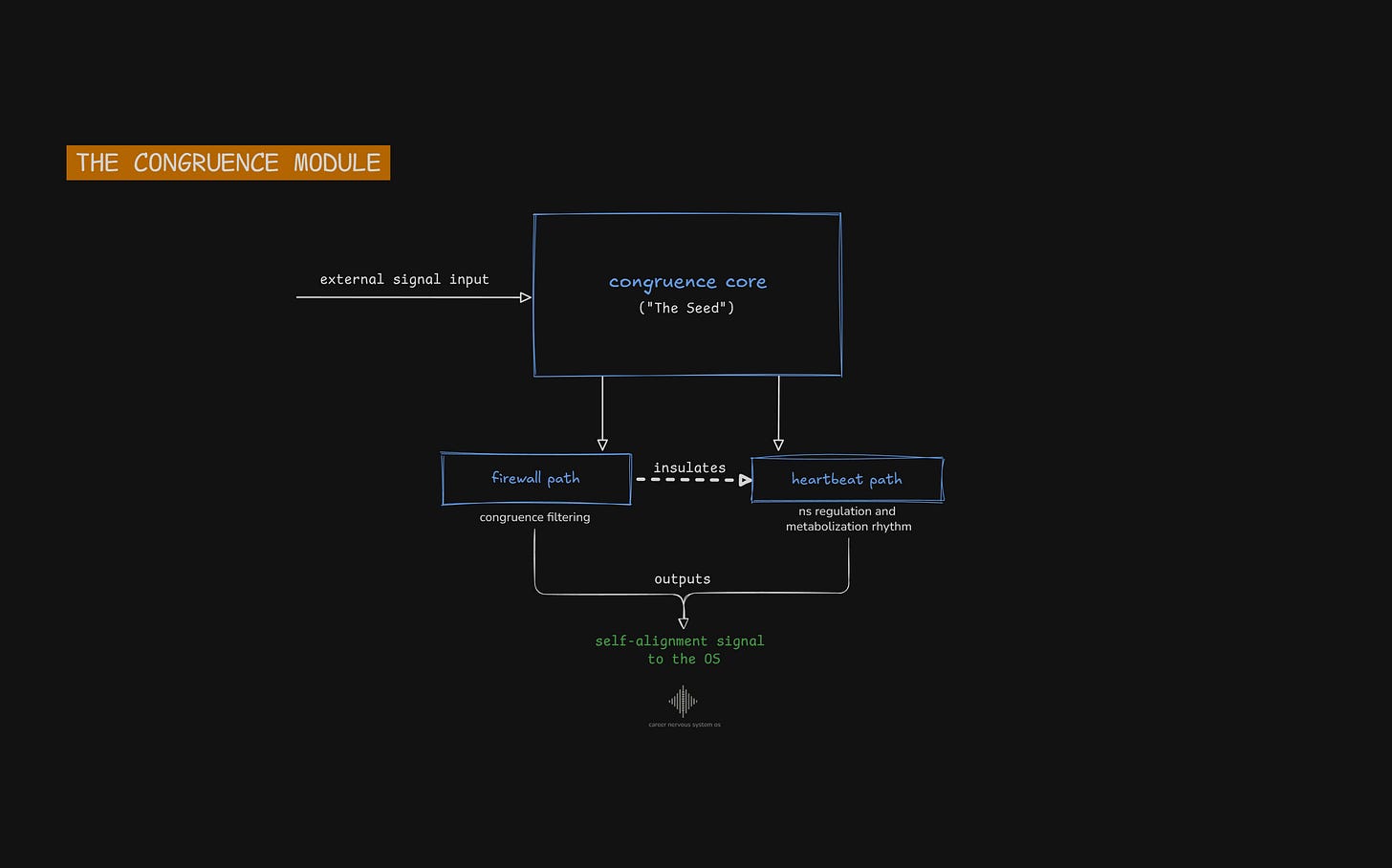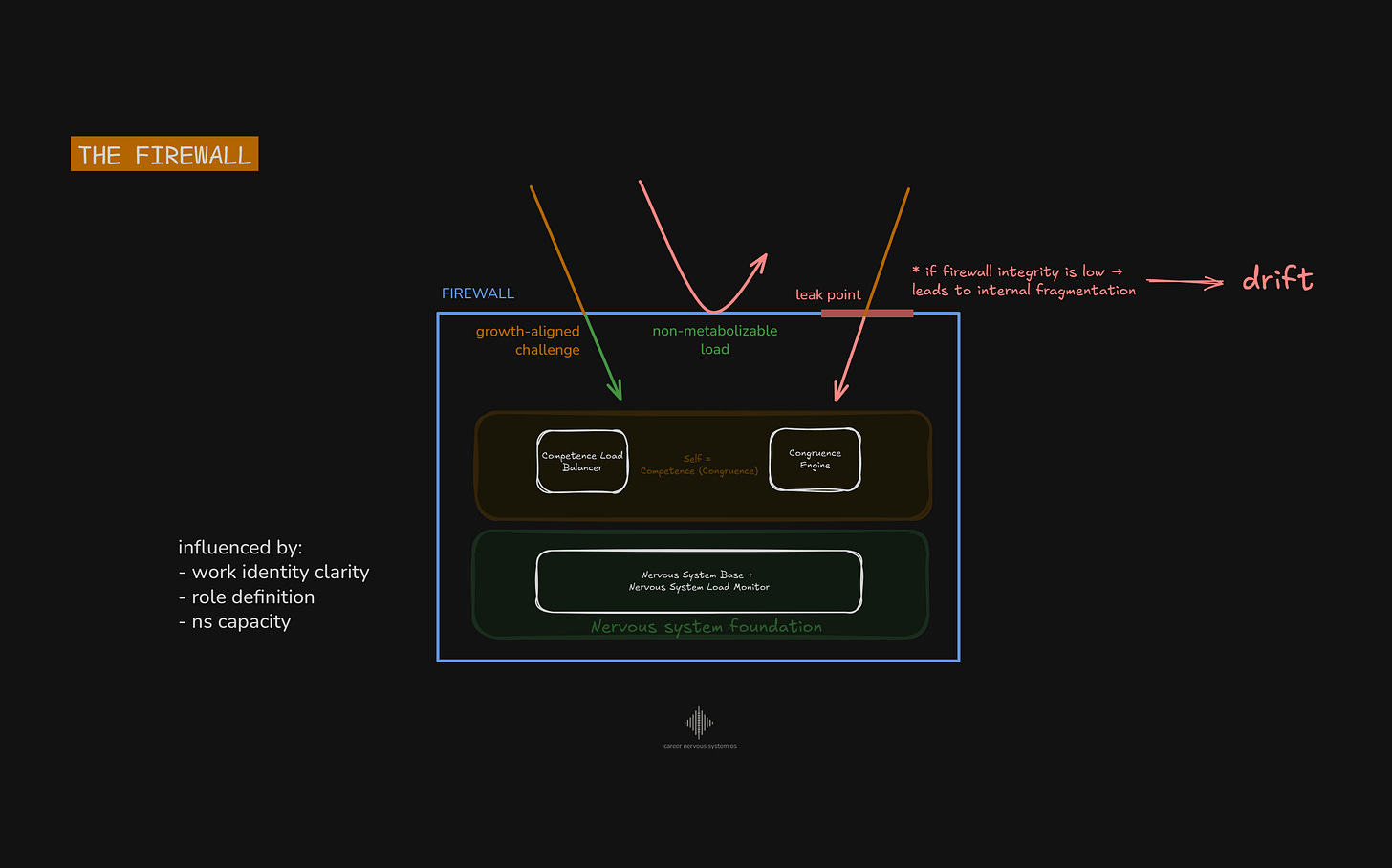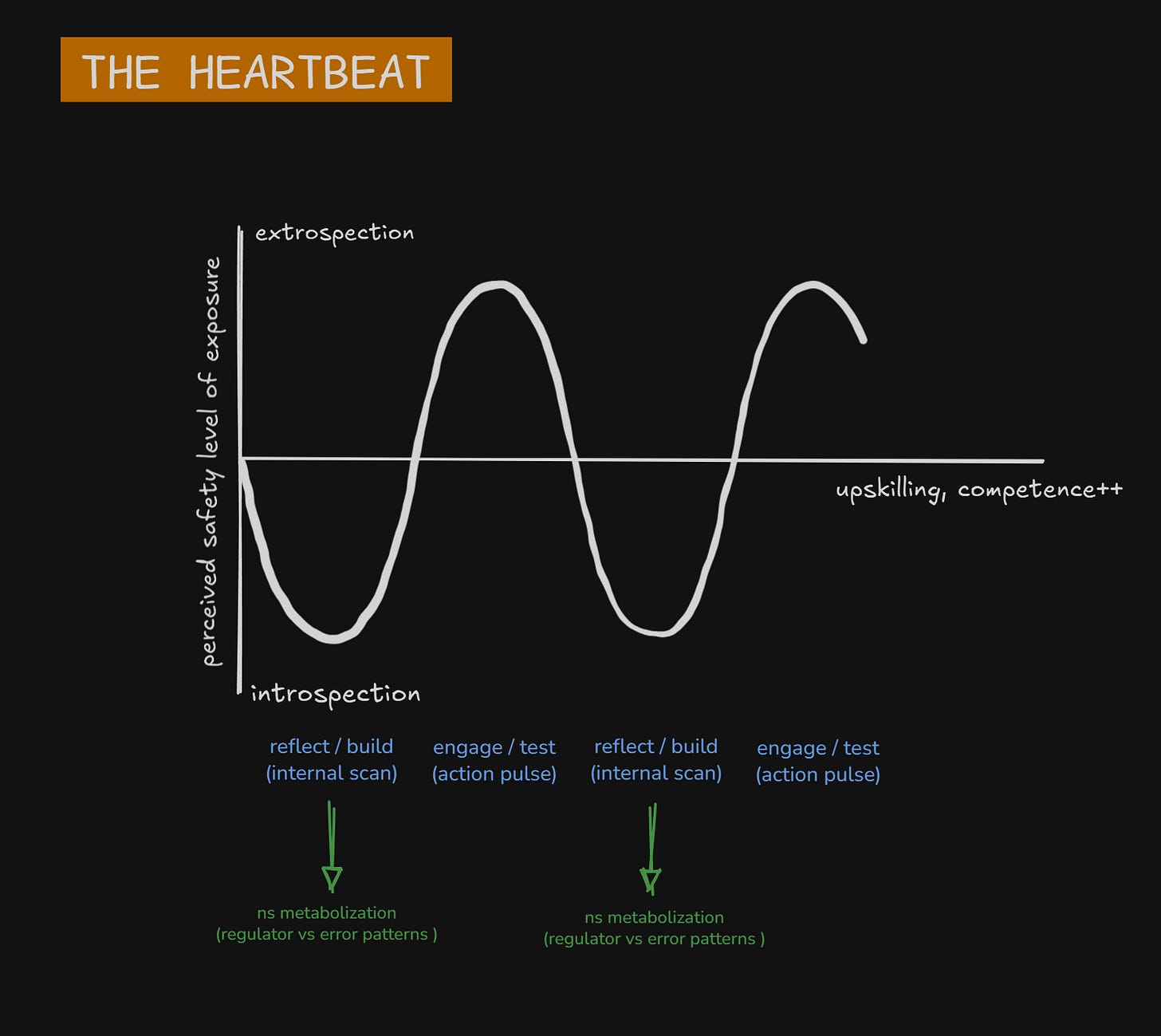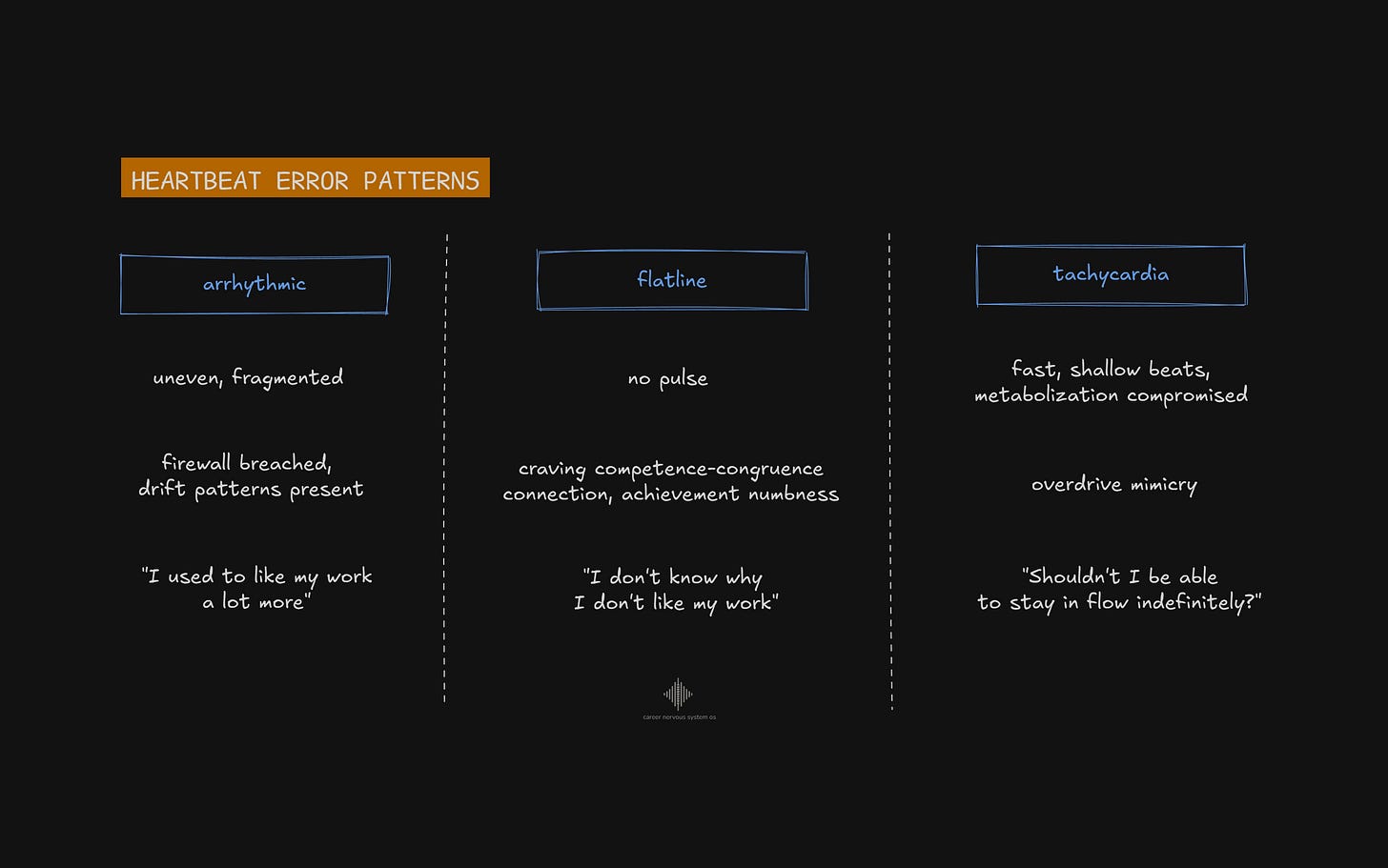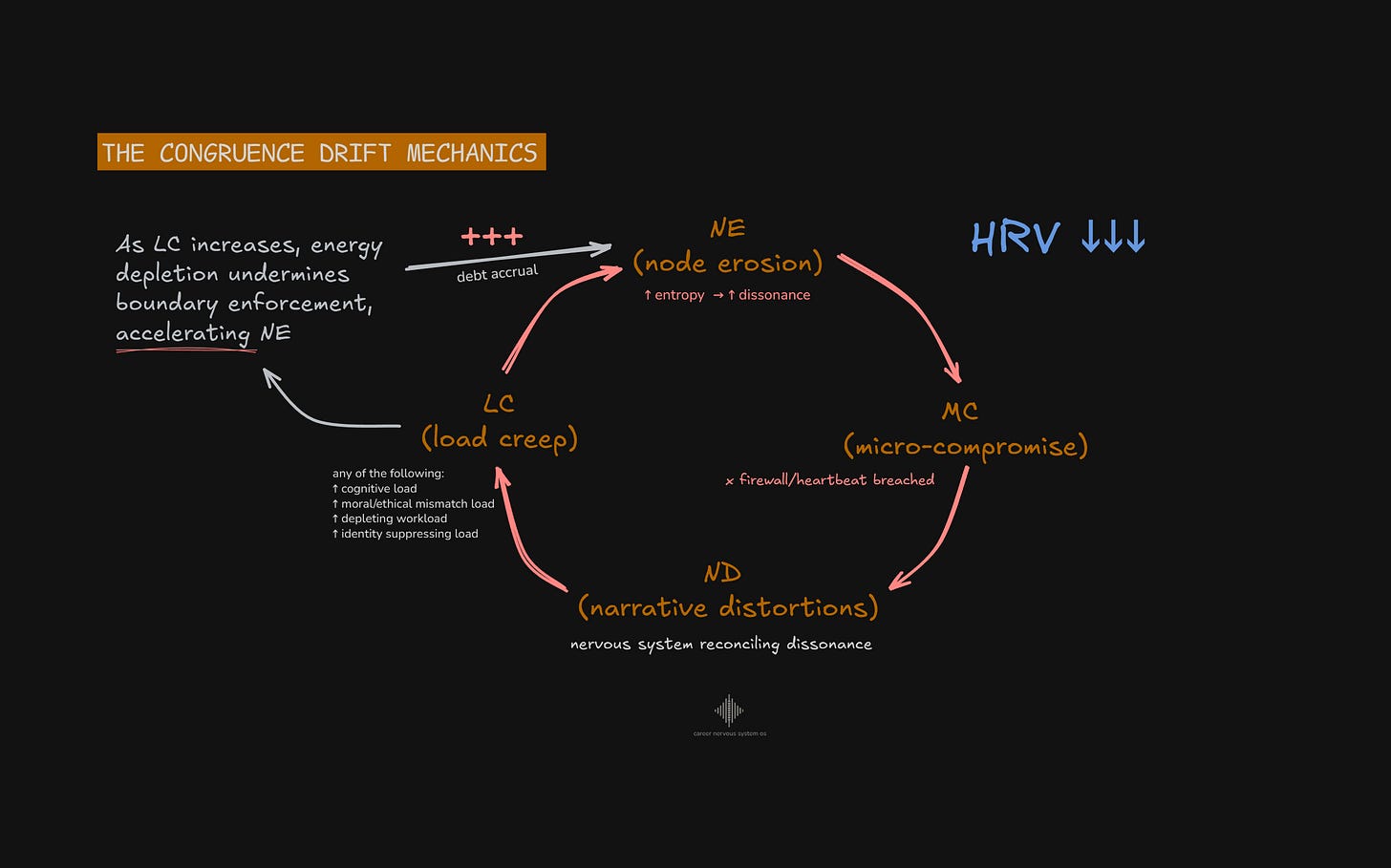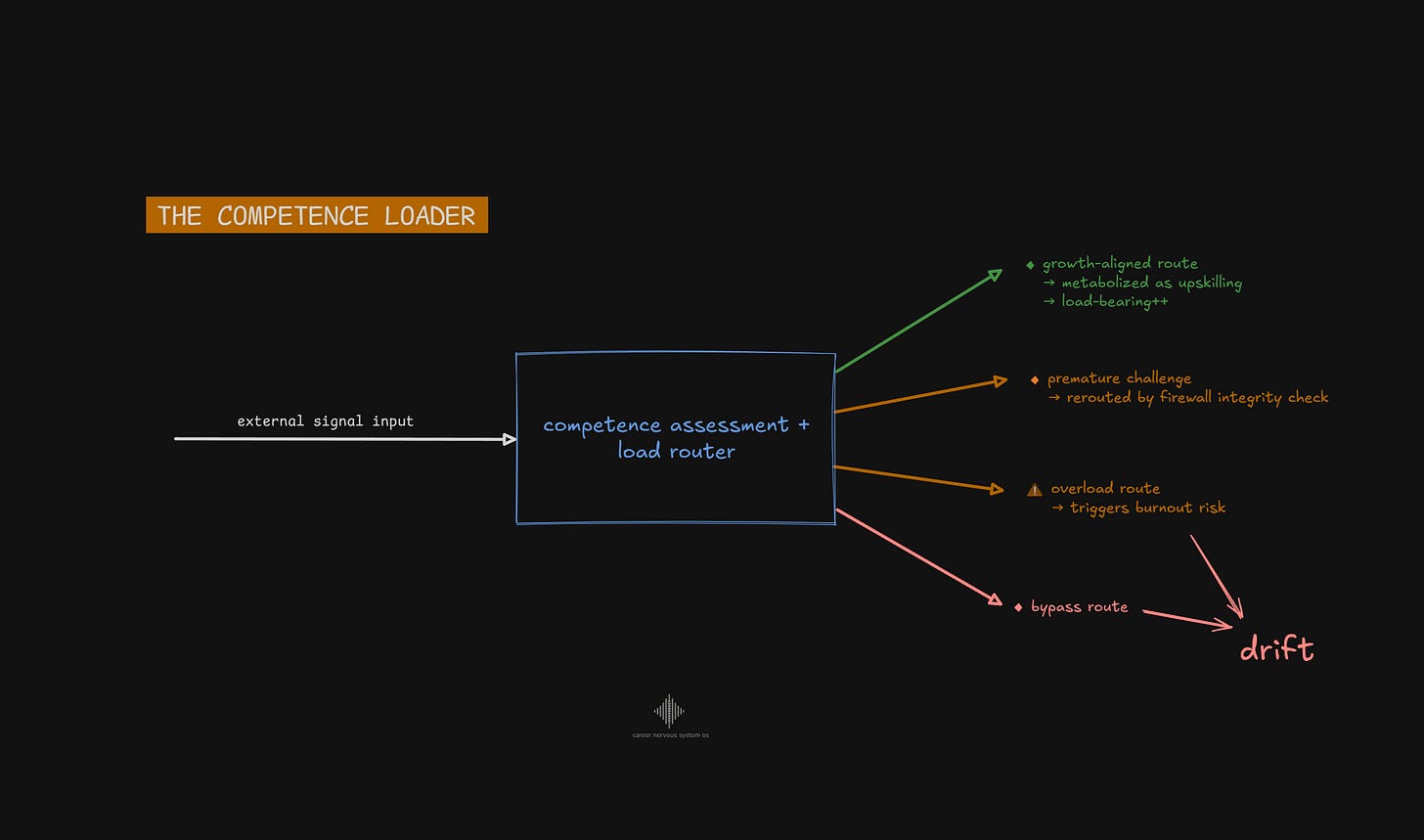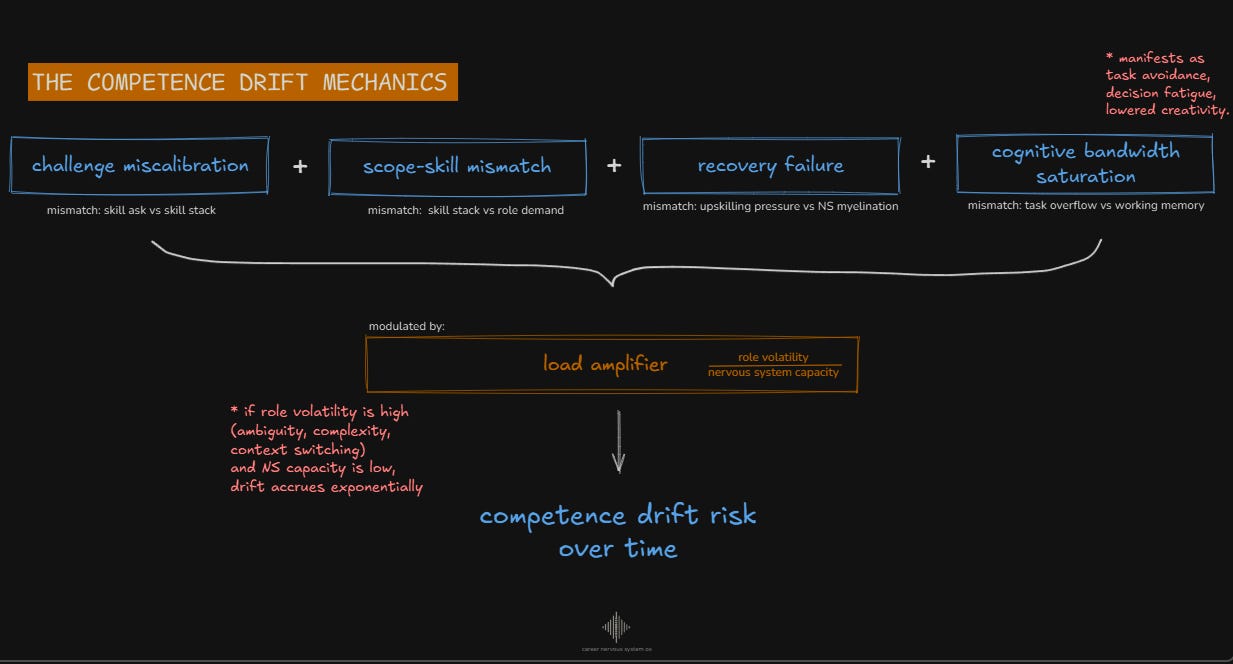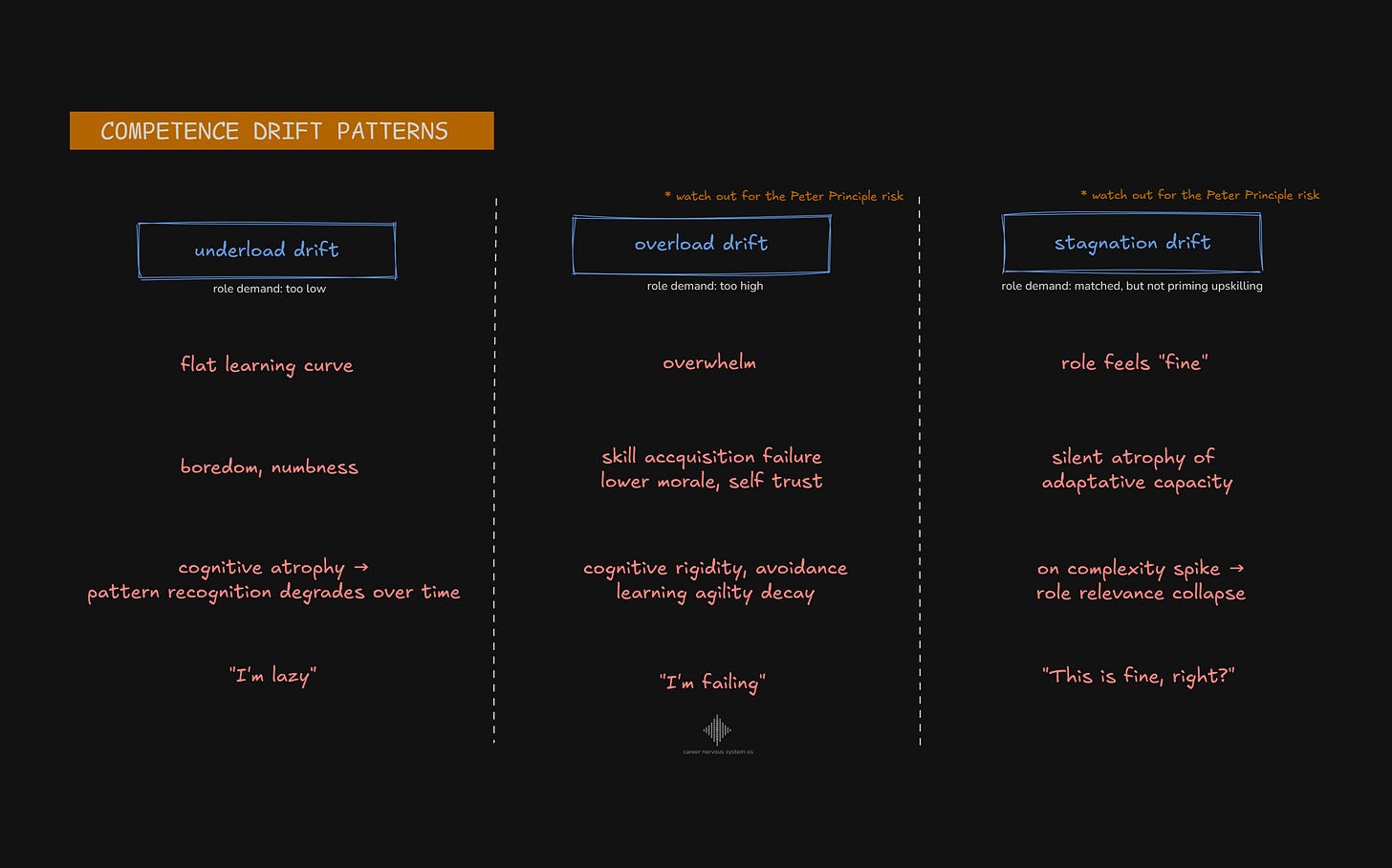Career Nervous System OS
v0 - release notes | July 2025
This is issue #2 of The Second Spine.
I build nervous system-aware tools for tech careers, and write about the system mechanics behind them.
If you want to design a resilient career in tech, subscribe for free.
You’ll get work-mapping tools, mental models, essays, and tactical breakdowns. Straight to your inbox.Updated: July, 22nd 2025.
The Nervous System OS is a conceptual operating system built from a modular collection of models stress-tested by my coaching practice and live experiments with field contributors.
What it is not:
Coded software.
A psychological or medical diagnostic tool
A personality or profile assessment
Seed Version (v0)
You can find the video introduction [here]. Table of Contents (OS Component Index)
This release includes all major diagnostic primitives, visual diagrams, and structural definitions currently in the public version of the Career Nervous System OS.
Each component below links to a dedicated section with:
A static diagram (if available)
Short-form specification
Release scope (v0 status: Alpha / Beta / Field-Tested)
Notes on future evolution (if available)
Top-Level Architecture
Congruence Principle
Competence-Congruence Binding Premise
Runtime Loop
Debug Loop
OS Dual Modalities: Constraint vs. Regulator
Collapse Spiral
Growth Spiral
Nervous System Foundation
Environment Layer
The Congruence Module (Seed)
Firewall
Heartbeat
Heartbeat Error Patterns
Congruence Drift Mechanics
Competence Loader
Competence Drift Equation
Competence Drift Patterns
(Clicking each will jump to the section when hosted on Substack.)
Version Context
This is the canonical public reference for OS version 0.1.
It represents the most current logic, vocabulary standard, and conceptual scaffolding for the Career Nervous System OS as applied to career architecture.
Status
Active Development
Stability
Fixed components are now field-consistent; evolving modules are flagged.
Field Testing
Most modules are undergoing structured validation via Second Spine Labs.
Update Schedule
New primitives will be added here only when stable. Version changelogs from ongoing research will be published separately for paid subscribers before consolidation in this document.
Purpose
This document is not a sales page, narrative arc, or a collective of in-depth posts on each component.
It is the equivalent of developer documentation.
It exists to reduce ambiguity, maintain concept hygiene, and clarify the edges of the current public release.
Component Documentation
Each section below will follow this format:
Release scope (v0 status: Alpha / Beta / Field-Tested)
🟡 Alpha: conceptually complete, now under structural pressure testing
🔵 Beta: stable, used live with real individuals.
🟢 Field-Tested: tested and validated in one or more experiments at The Labs.
Diagram
Purpose in the OS
Definition
Additional Notes (if necessary)
Top-Level Architecture
Release scope: 🔵Beta
Model
Purpose
The Top-Level Architecture defines the structural interface between external load, internal processing, and nervous system regulation.
It provides the foundational system map that governs how career input is metabolized through the OS layers.
All modules derive their position, dependencies, and failure points from this schema.
Definition
The OS is composed of three dynamic layers:
Environment Layer
→ Organizational Mechanics Debugger + Local System Lens
Captures and categorizes incoming load (chronic or adaptive) from both structural and interpersonal systems. Interprets volatility, design misalignment, and feedback density.Self Layer
→ Competence Load Balancer + Congruence Engine
Manages how external inputs are metabolized internally. Acts as the main processing core — where skill application and identity coherence either align or fragment.Nervous System Layer
→ Nervous System Base + Load Monitor
Tracks the physiological and cognitive impact of systemic load. Determines whether current conditions are generating adaptive regulation or accumulating structural stress.
Together, these three layers form a continuous metabolization loop — influenced by the OS’s runtime and debug loops, load filters (firewall, heartbeat), and internal routing mechanics (e.g., competence loader).
Congruence Principle
Release scope: 🔵Beta
Related posts: 1
Model
Purpose
The Congruence Principle introduces a second axis to career stability and fulfillment. One that traditional success metrics often ignore.
It formalizes how internal misalignment, even in high-competence roles, leads to nervous system degradation and eventual collapse.
This principle reframes career failure not as a personal shortcoming, but as a structural mismatch between identity congruence and role evolution.
Definition
If the Peter Principle says “employees rise to their level of incompetence,”
then the Congruence Principle asserts:
“One individual's career fulfillment breaks at their level of incongruence.”
Congruence is defined here as alignment between:
One’s internal work identity (as encoded in Seed Nodes)
The structure and signaling of their career environment
Incongruence arises when:
Roles reward output that’s detached from your core motivators
Visibility and praise mask misalignment
Career velocity outpaces the time needed to metabolize internal shifts
Unlike competence (which is validated externally)
congruence must be modeled and monitored internally.
Failure to do so leads to a slow erosion of agency, fulfillment, and trust in self, often interpreted as confusion, detachment, or sudden burnout.
Competence-Congruence Binding Premise
Release scope: 🔵 Beta
Related posts: 1
Model
Purpose
This premise explains a systemic failure pattern in high-functioning professionals:
Even when performance is strong, internal drift begins when the competence and congruence domains evolve out of sync. And can eventually completely decouple.
The binding premise formalizes that these two axes (skill and identity) must co-evolve for nervous system integrity to hold.
When the bond is strained or broken, the system enters misalignment, eventually triggering burnout, withdrawal, or collapse.
Definition
The Competence–Congruence Binding Premise states:
Career sustainability requires that your external capability (competence) and your internal coherence (congruence) grow in tandem.
Failure patterns emerge in four main configurations:
Bond Intact → Career direction is metabolized successfully
Congruence-Challenged → Identity erosion, fuzzy goals, muted satisfaction
Competence-Challenged → Skill-gaps, burnout risk, load overflow
Dual Failure → Career collapse, disorientation, deep nervous system debt
Unlike performance reviews or personality tests, this premise maps dynamic tension over time.
It provides a foundation for runtime diagnostics that can detect drift before collapse.
Additional notes
A lightweight diagnostic tool has been implemented to test this premise in early user-facing environments.
10 statements are graded by the user (0–10 scale)
Grouped into:
🟢 Competence Signals
🟡 Congruence Signals
🔴 Early Drift IndicatorsInterpretation logic segments users into:
Bond Secure
Congruence-Challenged
Competence-Challenged
Dual Drift Detected
Though not a full OS diagnostic, this tool is optimized for early pattern detection and gently introduces the binding logic to new users.
Its results will inform the design of a more granular version in Second Spine Labs.
Runtime Loop
Release scope: 🔵 Beta
Model
Purpose
The Runtime Loop governs how ongoing environmental input (tasks, requests, expectations) is metabolized by the OS under real conditions.
It is the nervous system’s live processing layer, translating external workload into internal strain, adaptation, or breakdown.
This loop is always running. Whether consciously modeled or not, its integrity determines whether career structure leads to growth or system degradation.
Definition
The Runtime Loop is the OS’s default operational circuit for metabolizing load in motion.
It follows this core flow:
Input Received → task, signal, demand enters via Environment Layer
Load Routed → passes through Firewall and Competence Loader
Processing Attempted → Self Layer activates Competence and Congruence processors
System Feedback → Nervous System Layer evaluates: regulate, adapt, or degrade
Loop continues — no pause unless intentionally interrupted (e.g. Debug Loop)
Critically, this loop can be overridden by acute load logic, the system’s built-in protocol to “push through” in high-stakes moments.
While adaptive in emergencies, chronic use of this override bypasses nervous system feedback and leads to stealth dysregulation.
The longer the system runs in override mode, the more incoherence is masked until collapse becomes visible.
The Runtime Loop is not inherently healthy or unhealthy. It simply mirrors the current metabolization capacity.
Its integrity depends on:
Congruence alignment
Nervous system margin
Environmental coherence
Presence of a functioning Debug Loop
Debug Loop
Release scope: 🔵 Beta
Model
Purpose
The Debug Loop is the OS’s self-correction circuit.
It activates when external reflection is injected, allowing the system to reorient before collapsing, or to guide chronic recovery.
Unlike the Runtime Loop, which processes input continuously, the Debug Loop initiates a temporary pause so that internal misalignment can be surfaced and addressed.
This is the only mechanism in the OS that grants system-level reflection while under load.
Definition
The Debug Loop is a four-phase sequence that reroutes nervous system attention away from throughput and toward system integrity.
Its cycle is:
Observe
The system slows down and becomes aware of discomfort, confusion, drift, or incoherence.
Observation happens without immediate judgment or reactivity.Diagnose
A hypothesis emerges about the source of misalignment.
This may involve identifying incongruent values, faulty assumptions, outdated constraints, or unacknowledged stressors.Intervene
A specific change is made.
The system adjusts a variable, imposes a boundary, escalates a need, or pauses a commitment.
The goal is to create enough state change to test whether the hypothesis was correct.Recalibrate
The loop closes by checking if nervous system regulation has been restored.
If not, the cycle continues until a new equilibrium is reached or a deeper OS-level diagnostic is required.
The Debug Loop is fragile when system load is high or override behavior is chronic.
Many professionals delay entering this loop until breakdown is imminent, not because they lack insight, but because they lack margin and structural permission to stop and self-interrogate.
Without the Debug Loop, insight stays trapped in the nervous system as background noise.
With it, insight becomes diagnostic information that can be acted on before burnout takes root.
Additional notes
In future releases, the Debug Loop will anchor new OS rituals that can be practiced in the margins of high-load environments.
This includes short-form audit prompts, systemic trigger tracking, and environment recalibration heuristics.
OS Dual Modalities: Constraint vs. Regulator
Release scope: 🔵 Beta
Model
Purpose
This component encodes the two polar modes in which a career structure can interact with your nervous system.
Each OS primitive can either deplete or reinforce your system based on which modality is active.
Recognizing the current mode helps interpret drift, misalignment, or energetic collapse as mechanical consequences of modality misplacement rather than as personal inconsistency.
Definition
The Nervous System OS operates in one of two distinct polar modalities:
Constraint Modality
In this state, your career acts solely as an energy-depleting consumer.
It extracts output from your nervous system without supporting its regulation.
This mode is often active when the system is under chronic load, emotional detachment, or high performance pressure.
In this mode, the system may still function, but the cost accumulates silently.Regulator Modality
Here, your career still consumes energy, but it is also able to act as a generator and modulator.
The system selects for adaptive stress and supports a neurochemical state conducive to restoration, learning, and performance under challenge.
In this mode, nervous system integrity improves over time, and capacity increases.
The OS shifts between modalities based on load conditions, seed stability, and loop health.
You do not cognitively choose this state. Your system enacts it based on your ability to metabolize challenge, derive reward, and recover.
Constraint mode is not failure.
It is a signal that the OS is preserving its core under unmanageable conditions.
Regulator mode is not a permanent target.
It is an indicator that the current system design is metabolically aligned.
Collapse Spiral
Release scope: 🔵 Beta
Model
ns overload → competence access ↓ → drift ↑ → ns load ↑ loop
Purpose
The Collapse Spiral maps what happens when the nervous system operates under the Constraint modality.
It explains how even highly competent individuals can become unable to access their skills, leading to systemic degradation that traditional interventions cannot resolve.
This spiral is one of the OS’s primary drift pattern detectors.
It operates silently until system access begins to fail.
Definition
The Collapse Spiral describes a compounding loop that begins with nervous system overload and ends in identity erosion.
The sequence follows:
Nervous System Overload
The system begins in a state of persistent or cumulative pressure.
This can come from chronic override, high emotional labor, misaligned values, or sustained complexity.Competence Access Decreases
Skills that were once fluid become brittle, slower, or cognitively expensive.
Even simple tasks feel heavier. Strategy weakens. Micro-decisions generate friction.Drift Increases
As competence access drops, a sense of internal misalignment emerges.
Emotional flatness, resentment, or detachment begin to surface.
The individual is still performing, but not metabolizing.Load Increases Again
Because drift consumes regulatory margin, the same environment now feels heavier.
The system has less capacity, but the same demands.
The nervous system re-enters overload with reduced recovery potential.
This sequence loops silently.
From the outside, the individual may still appear high-functioning.
From the inside, something essential is quietly breaking.
This is not burnout from failure.
This is burnout from prolonged success in systems that ignore nervous system cost.
This pattern will eventually sever the competence-congruence bond.
Growth Spiral
Release scope: 🔵 Beta
Model
metabolizable load → competence access ↑ → congruence reinforced → ns bandwidth ↑ → metabolizable load ↑ loop
Purpose
The Growth Spiral defines the system state in which challenge increases capacity instead of eroding it.
It is the opposite of the Collapse Spiral, but not a mirror image.
Where collapse compounds from overload and drift, growth compounds from metabolizable input and congruence.
The Growth Spiral is a regulated feedback loop that produces resilience, clarity, and skill fluidity over time.
Definition
The Growth Spiral is a compounding loop that occurs when two conditions are met:
The system is being exposed to metabolizable load
The system’s congruence integrity is unbroken
When these two prerequisites are true, the loop follows this sequence:
Metabolizable Load Enters
Input is challenging, but not chaotic.
The Firewall identifies the ability to process it without bypass or suppression.Competence Access Increases
Skills become more fluid and reliable.
The nervous system has margin to adapt in real time and update internal models.Congruence is Reinforced
Identity congruence is strengthened.
The system receives internal confirmation that growth is happening in the right direction.Nervous System Bandwidth Expands
The system becomes more robust.
Load that would have triggered dysregulation before is now manageable.
The result is not just tolerance, but increase of personal capacity and fulfilment.
This state does not require perfect conditions.
It requires just enough margin, coherence, and structure to allow pressure to align with your work identity instead of leading to personal fragmentation.
The Growth Spiral is not flow.
It is metabolically-aligned pressure that reinforces self-trust and system capacity over time.
Nervous System Foundation
Release scope: 🟡 Alpha
Model
Purpose
The Nervous System Foundation governs the OS’s dynamic range and modulation.
It determines how much pressure the system can handle, how fast it can recover, and how coherently it can operate under load.
This foundation directly shapes whether system primitives function as intended, or begin to distort.
Definition
The Nervous System Foundation consists of two subcomponents:
1. Nervous System Base
This sublayer defines the system’s Window of Tolerance, the regulated zone in which both competence and congruence can be accessed fluidly.
The shape and resilience of this window are determined by a set of internal neuroparameters, including:
HRV (Heart Rate Variability)
Setpoint Resilience (baseline capacity of your nervous system to handle stressors and return to homeostasis.)
Recovery Rate (how quickly your nervous system can shift from sympathetic e.g. alert, mobilized states back into parasympathetic e.g. restorative states)
Default Mode Bias (system inherently prone to hyperarousal or hypoarousal)
2. Nervous System Load Monitor
This sublayer is responsible for real-time decomposition of incoming load.
It helps determine whether the system is over-extended, under-activated, or metabolically aligned.
The load monitor classifies five categories of pressure:
Cognitive Load (problem-solving, decision-making, task switching.)
Emotional Load (interpersonal stress, unprocessed emotions, relational complexity.)
Physical Load (fatigue, exertion, illness, sleep debt)
Environmental Load (sensory noise, calendar fragmentation, digital saturation)
Existential Load (uncertainty about career direction, identity, or life meaning.)
Without this classification, the system may misdiagnose its own dysregulation and reach for the wrong intervention.
When NS load is untracked or window of tolerance is narrowed, congruence access becomes distorted and competence becomes brittle.
Additional notes
Both subcomponents are in Alpha.
The science behind nervous system modulation is well-established, but the OS’s internal modeling of these parameters requires additional testing to define thresholds, interactions, and systemic markers across different user baselines.
Environment Layer
Release scope: 🔵 Beta
Model
Purpose
The Environment Layer captures the external operating conditions that shape nervous system function and OS behavior.
It injects signal, tests system flexibility, and reveals hidden fault lines in coherence.
Environment is not passive. It is an active modulator that interacts with both regulation and identity.
This layer also defines the upstream source of most misdiagnosed performance problems.
Definition
The Environment Layer introduces pressure into the system via three interacting forces:
Volatility
The rate and nature of change.
This includes context switching, ambiguity, reversals, and shifting demands.
High volatility requires rapid state transitions and short recovery loops.Complexity
The number of nested systems and interdependencies.
This is not just task load, but architecture load — it describes the mental effort required to hold and navigate a layered environment.Load Density
The simultaneity and urgency stacking present in the environment.
It affects how narrow or wide an individual's decision-making bandwidth can be.
Common expressions include calendar crowding, slack fire drills, and high-reactivity cultures.
Each of these environmental inputs is shaped by mechanics:
Org Mechanics define structural constraints: power distribution, decision autonomy, communication tempo.
Local Mechanics shape micro-environments: team culture, leadership tone, emotional safety.
These forces are interpreted by the Nervous System Foundation, and metabolized through the Self Layer (Competence and Congruence stack).
Together, they shape tone interpretation, signal processing, and output behavior.
In OS terms, environment is not where you are.
It’s the pressure signature your system must metabolize to operate.
The Congruence Module (Seed)
Release scope: 🔵 Beta
Model
Purpose
The Congruence Module is the OS’s decision engine for internal alignment. It defines how work is metabolized at the identity level and determines whether your nervous system will register career effort as congruent or erosive. Its structure enables the nervous system to regulate itself through work, rather than in spite of it.
Definition
At the core of the module is the Seed: a collection of work identity nodes. Each node pairs a precise function (title) with a contextual frame (description). Together, they define what “aligned work” means to the individual.
The module listens for external inputs and maps them against the Seed. Based on that mapping, it routes signals through two distinct primitives:
The Firewall, which filters non-metabolizable input by enforcing integrity across protective Seed nodes
The Heartbeat, which produces rhythmic output loops tied to regenerative Seed nodes
The firewall insulates the heartbeat path. When both are operational and intact, the module generates a continuous self-alignment signal to the OS, stabilizing regulator mode.
Additional notes
The concept of work identity nodes is not to be confused with personal identity. These nodes are designed to encode the minimal viable configuration of meaningful work for an individual. They are not static labels. They are metabolization coordinates.
A stabilized Seed allows the system to lock into regulator mode and expand capacity sustainably. A fragmented Seed introduces incoherence into both runtime and recovery loops, even when performance remains externally consistent.
Firewall
Release scope: 🔵 Beta
Model
Purpose
The Firewall filters external signal through the lens of identity integrity.
Its function is to prevent non-metabolizable load from entering the self-regulation system.
When intact, it ensures that only growth-aligned challenge reaches the core system for processing.
When breached, it leaks corrosive input into the system, leading to identity fragmentation and performance drift.
Definition
The Firewall is the OS’s congruence buffer.
It evaluates incoming load and determines whether the signal:
is metabolizable (growth-aligned and interpretable by the system)
or corrosive (disorienting, incoherent, and structurally incompatible)
A healthy Firewall routes metabolizable challenge into the self-core (Competence Load Balancer and Congruence Engine)
It deflects what the system cannot yet process without harm.
But when the Firewall is overridden non-metabolizable load slips through.
This creates leak points in the system, which degrade output fidelity, drain nervous system capacity, and gradually sever congruence loops.
Firewall performance is shaped by:
Work identity clarity (coherence across Seed nodes)
Role definition (clear scope, authority, and alignment zone)
Nervous system capacity (baseline resilience and recovery bandwidth)
If these three are weak or unstable, firewall resolution drops, and the system will struggle to detect incongruence until symptoms escalate.
Nodes will have independently resilence thresholds and withstand different amounts of pressure.
Firewall breakdown is commonly invisible at the surface. Individuals still appear competent, even accelerate. But internally, noise is pushing to be metabolized and scrambling most signals in the OS.
In most collapse spirals, this is the first failure point.
Heartbeat
Release scope: 🔵 Beta
Model
Purpose
Acts as the core metabolic rhythm of the OS.
It directly links competence progression to nervous system regulation.
The heartbeat defines how an individual’s identity is experienced through output.
Definition
The Heartbeat is a dynamic output loop that pulses between two nervous system states: build and engage.
This pulse is modulated by the individual’s perceived safety of exposure.
This preference is shaped by both brain architecture and the nervous system’s current regulation state.
The loop is composed of regenerative Seed nodes.
These are not abstract ideals. They are concrete expressions of an individual’s work identity.
They define how the nervous system metabolizes both the act of building and the experience of being perceived as useful both to itself and by the group.
In the downshift (build), the system reflects and consolidates.
The nervous system metabolizes current OS modality (constraint or regulator).
Competence and congruence may reinforce connection or further fracture.In the upshift (engage), the system outputs and exposes.
Identity is made legible through real-world interaction.
Reward circuits activate only if the output aligns with congruence primitives.
When this pulse is healthy, the brain releases potent neurochemicals such as dopamine, acetylcholine, and norepinephrine.
These compounds increase load capacity, drive fulfillment, and strengthen identity integration under pressure.
Additional notes
Heartbeat profiles vary widely.
Even individuals with similar work roles and surface preferences may extract meaning from entirely different parts of the pulse.
This is why output sameness does not equal congruence.
Only the internal pulse can reveal metabolization quality.
Heartbeat health is the most reliable proxy for nervous system alignment in high-performance environments.
Heartbeat Error Patterns
Release scope: 🟡 Alpha
Model
Purpose
Maps the most common failure modes of a fractured Heartbeat. These patterns emerge when the pulse between build and engage is compromised, and the nervous system can no longer metabolize output into congruence.
Definition
The Heartbeat operates as a metabolization rhythm. When its regulation fails, the system begins to emit distorted pulses, predictable error signatures that signal where internal congruence has broken down.
Each error pattern reflects a distinct nervous system configuration and metabolization failure:
1. Arrhythmic
Pattern: Uneven, fragmented, unpredictable pulses
Cause: Congruence erosion or unresolved drift
Symptom: "I used to like my work a lot more"
Interpretation: There’s still residual meaning, but congruence is breaking. The individual alternates between overextension and retreat. Often found in high performers post-promotion or post-pivot.
2. Flatline
Pattern: No visible pulse
Cause: Disconnection from work identity and values
Symptom: "I don’t know why I don’t like my work"
Interpretation: The individual may be competent but emotionally unanchored. Neither congruence nor output generates a metabolic response. Apathy or numbness often sets in. This state is rarely caused by workload alone. Work identity obscurity is often the root.
3. Tachycardia
Pattern: Fast, shallow pulses, no recovery
Cause: Overdrive mimicry, often in high-visibility environments
Symptom: "Shouldn’t I be able to stay in flow indefinitely?"
Interpretation: The system has confused visibility with vitality. Competence is being deployed reactively, not regeneratively. Output velocity is high, but meaning is absent. Congruence is bypassed.
Additional notes
These patterns are in Alpha.
The science behind their modeling is well-established, but they requires additional testing to define repetition and detailing across different user baselines.
Congruence Drift Mechanics
Release scope: 🟡 Alpha
Model
Drift Debt (DD) = ∑ [(MC(NE) + ND(MC) + LC(ND) + NE(LC)) × Δt]
Purpose
Maps the systemic architecture behind congruence degradation. This loop reveals how internal dissonance compounds gradually, until the individual’s output no longer reflects their identity.
Definition
Congruence Drift Mechanics outlines the hidden loop that drives chronic identity misalignment in knowledge workers.
It begins with Node Erosion (NE). Often triggered by an environmental signal, this marks the initial entropy event, one or more work identity nodes lose clarity or anchoring. Congruence becomes harder to assert, and internal dissonance increases.
Next comes Micro-Compromises (MC). These are subtle behaviors or decisions that conflict with the individual’s internal model. They often appear harmless, surfacing as minor discomforts rather than integrity breaches.
To maintain internal cohesion, the nervous system generates Narrative Distortions (ND). These are protective stories that metabolize the dissonance cognitively, even if they distort the signal somatically. At this point, the system is no longer processing experience truthfully.
This cognitive override enables Load Creep (LC), a gradual accumulation of unresolved pressure that bypasses conscious detection. It may take the form of moral compromise, identity suppression, or persistent cognitive overexertion. Over time, this load depletes bandwidth and undermines regulation.
The loop completes when this unprocessed load feeds back into the system, accelerating further node erosion. HRV suppression is a common physiological signature.
This model is especially relevant in high-functioning professionals, where external performance conceals rising internal fragmentation. In these cases, narrative distortions become harder to detect, even by the self.
Additional notes
These mechanics are in Alpha.
The science behind its modeling is well-established, but they requires additional testing to define repetition and detailing across different user baselines.
Competence Loader
Release scope: 🟡 Alpha
Model
Purpose
Routes external signals through the nervous system based on load metabolization capacity and current competence integrity. Determines whether a challenge can be metabolized as upskilling or creates tension due to mismatch.
The Competence Loader is a signal-processing mechanism that evaluates incoming stimuli against an individual's skill stack, nervous system bandwidth, and current metabolization state.
It acts as a load router. When a signal arrives, the system must decide how to handle it. The loader continuously evaluates: Is this load metabolizable right now? Does it match the current competence tier?
Definition
There are four possible routing outcomes:
Growth-aligned route
The load is metabolizable and matches the individual’s upskilling frontier. It can be stored as long-term adaptive capacity.Premature challenge route
The load is potentially growth-aligned but bypasses readiness checks. If the firewall reroutes it, it is buffered safely. If not, it risks internal fragmentation.Overload route
The load may match skill readiness but exceeds current bandwidth. This leads to energy depletion. Repeated exposure increases burnout risk and node erosion.Bypass route
The load circumvents the internal model entirely. This produces output the system cannot metabolize. Congruence is bypassed. Drift becomes inevitable.
The loader does not only assess technical capability. It also scans for psychological safety, context clarity, and nervous system regulation. Its judgment governs whether a task strengthens the system or increase drift.
This is one of the few components that activates with every external task input, regardless of scale. Its accuracy is shaped by role definition, manager signaling, and how well the external environment matches internal models. Drift triggered here often gets misread as overwork or "capacity issues" when in fact, identity bypass is the root.
Additional notes
This component are in Alpha.
The science behind its modeling is well-established, but they requires additional testing to define repetition and detailing across different user baselines.
Competence Drift Equation
Release scope: 🟡 Alpha
Model
Drift Risk (CD) = [(Challenge Miscalibration + Scope–Skill Mismatch + Recovery Failure + Bandwidth Saturation) × Load Amplifier] over Time
Purpose
Models how competence degrades when load is miscalibrated over time. This mechanic reveals the accumulation pathways that lead to misalignment between the individual's actual skill capacity and the system’s perceived capability.
It helps explain why competence degradation often masquerades as fatigue, low motivation, or self-doubt, when the underlying issue is architectural.
Definition
The Competence Drift Equation outlines the key ingredients behind sustained performance breakdowns in high-complexity roles. It describes a drift equation shaped by four interacting forces:
Challenge Miscalibration
The type of task no longer matches the skill it is meant to activate or develop. This may stem from ambiguity, misplaced stretch goals, or a lack of rhythm between demand and actual capability.Scope–Skill Mismatch
The current skill stack cannot meet the demand embedded in the role. This is not simply a knowledge gap but a structural mismatch between what the role requires and what the nervous system can reliably reproduce. This mismatch often originates upstream, through failures traceable by the Org Mechanics Debugger or Local System Lens. When placement or scoping errors occur, dysfunction migrates inward.Recovery Failure
Even metabolizable challenges become unsustainable when recovery between upskilling pulses collapses. The space between input and integration compresses, disrupting nervous system myelination and eroding adaptive stability.Cognitive Bandwidth Saturation
Working memory hits a ceiling. The nervous system is flooded with unresolved threads. This reduces creativity, weakens strategic vision, and can lead to performance collapse through task avoidance or reactive spirals.
At the center of this equation sits the Load Amplifier. It modulates how heavily the OS is favoring the Acute Load Pathway over the proper Runtime loop. (see Runtime loop section)
Role Volatility: Ambiguity, shifting expectations, nested decision layers.
Nervous System Capacity: Recovery rate, current load, regulation anchors.
When volatility is high and NS capacity is low, drift accrues exponentially. This is often misread as underperformance, when in reality it is a failure of load routing and metabolization.
Additional notes
These mechanics are in Alpha.
The science behind its modeling is well-established, but they requires additional testing to define repetition and detailing across different user baselines.
Competence Drift Patterns
Release scope: 🟡 Alpha
Model
Purpose
Maps the most common patterns of competence degradation when role demand diverges from metabolizable challenge.
These drift profiles help differentiate between three superficially similar states: boredom, overwhelm, and disengagement. Each is driven by distinct misalignments between task architecture and skill development.
When named correctly, these patterns reveal where to intervene: environment, challenge design, or nervous system recovery.
Definition
Competence Drift Patterns categorize how role-skill mismatches distort perception, degrade learning agility, and erode adaptive capacity.
There are three core drift types:
Underload Drift
Role demand is too low.
The learning curve flattens. Engagement wanes. Boredom and numbness become baseline.
Without challenge, pattern recognition dulls and cognition atrophies.
This drift is often internalized as a character flaw.
Default narrative: “I’m lazy.”Overload Drift
Role demand is too high.
The system is flooded. Morale drops. Skill acquisition stalls.
Cognitive rigidity replaces adaptive flow.
Firewall integrity is often breached here, accelerating node erosion.
Default narrative: “I’m failing.”
Watch for Peter Principle risk: performance masks may be sustained just long enough to earn a promotion, but if the load was unsustainable, collapse often follows.Stagnation Drift
Role demand is matched, but not metabolizing as upskilling.
The role feels “fine,” but the nervous system is under-stimulated.
Silent atrophy sets in. When complexity spikes, role relevance collapses.
Default narrative: “This is fine, right?”
Also prone to Peter Principle dynamics, but from a different angle. Individuals may seek promotion to override a growing sense of stasis. If next-tier competence isn’t actively being built, the leap becomes structurally unsound and may trigger collapse.
These patterns don’t just reflect individual performance. They signal how poorly-scoped roles and unchecked load evolution can degrade competence. Even when intent and effort remain high.
Additional notes
These patterns are in Alpha.
The science behind their modeling is well-established, but they requires additional testing to define repetition and detailing across different user baselines.
If you enjoyed this read, the best compliment I could receive would be if you shared it with one person or restacked it.
If you liked this post consider subscribing for free.
You’ll get work-mapping tools, mental models, essays, and tactical breakdowns. Straight to your inbox.
© 2025 Luciana Santos. All rights reserved.
The Career Nervous System OS™ is an original framework authored by Luciana Santos. Its models, language, and diagnostic architecture are protected under U.S. and Brazilian copyright law.
No part of this system may be copied, modified, or republished without explicit permission.


